Around the time when early humans started making steel and hunting weapons, a real-life GOT character, Ned Stark was beheaded in Iron Age. But his skull along with brain was buried in clay-rich mud and it remained there until York Archaeological Trust researchers found it in 2008. Recently a study was published which answered many puzzling questions.
The finding of Iron Age human brain
The researchers found the well-preserved skull in Heslington, which is a suburban village near modern-day York in England. But what they found inside the skull shocked them.
After finding the skull they noticed a large chunk of brain. Even though the brain was already thousands of years old, the researchers found it in tact, a remarkable situation. Now known as the "Heslington brain", the brain tissue had shrunk slightly over the years but still, researchers were able to find out the usual brain grooves and folds.

Well preserved brain
As per the experts, this brain is not only considered the oldest preserved brain ever found in Eurasia but also the best-preserved ancient brain of all time. Researchers revealed in the study, which was published in the journal Royal Society Interface, that the brain belonged to an Iron Age man but survived all these years.
It should be noted that after a person dies a process called autolysis causes all the organs to break down. In terms of the brain, it includes 80 percent of water and this particular part of the human body is one of the organs to go down first. In usual cases, within 10 years the brain tissues completely degrade, but it did not happen to the Iron Age human brain.
What researchers found in the ancient brain?
Further analysis of the Heslington brain revealed that it was protein clumping which made the brain endure. It means that without any artificial help the brain actually preserved itself.
After detailed analysis, researchers discovered that certain proteins, which help the structure of nerve and brain cells like neurons and astrocytes, were found as clusters in brain tissue. The protein rush helped the brain to keep stable over thousands of years and helped to slow down the decomposition procedure.
While conducting this research, the experts also came to know that the natural proteins of this brain were more stable than modern-day brains and their stability showed how well the protein functions were. However, the researchers are not sure what caused the critical clumping process but they are speculating that it could be something to do with the burial process of the skull.









